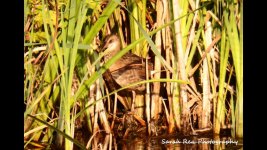My First early start of the Autumn
Just back from a 6 o'clock start. Although still a bit early for any real autumn movement, there was evidence of a local build up of passerines. South of the main hide several warblers were 'flycatching' from the top of the fox fencing, including my first 'lemon' juvenile WILLOW WARBLERof the autumn, sedge warbler and several chiffchaffs. Goldfinches were gathering to feed on the thistle heads, while pied wags and linnets were foraging in front of the hide on cattle disturbed areas. All around the cuckoo hide there were 'churring' juvenile reed warblers, the parents replying with a soft 'chack' as they crashed through the reeds in search of food for them. These sounds are also emitted from scrub and willows close by, so if you are not too familiar with these sounds it can be frustrating trying to find the associated bird. However when you are aware of it, you realise just how many reed warblers there on the reserve. From the Hen pool hide smaller numbers of reed warblers were on show but a sedge and a singing cettis warbler added to the variety. Back to the lagoons, were wader movement was barely discernible. But a small increase in avocet and a dunlin added to the general impression that things were about to 'start' ( well it is August next week). As a result of the BHG and Avocet invasion, previously common breeding birds such as the Moorhen tend to breed later usually when the avocet and gulls have gone. So now several very small chicks of this species are appearing all around the Flashes, although the late breeding avocets do not tolerate them when they get near to their ' feeding zones'. Sadly the sitting LRP is no longer, well its there just not sitting. The oystecatcher chick growing well and receiving small items regularly. There were a few rooks moving overhead. as well as swallows and house martins, while a peregrine stood guard on the small mast.
species count FLASHES
Teal 14, shelduck 2 juvs, mallard 130 , no tufted Little grebe juv - 1st flash.
Avocet 10 ads + 3 juvs + 9 chicks, Lapwing 40, oystercatcher 2 + ch, LRP 4 (2 ads + 2 juvs), common sand 3 all ads, green sand 8 (min), snipe, dunlin, BHG 250, LBBG 5 all chased off by avocets, - in fact when some LBBG appear, they immediately change direction just upon hearing the avocet alarm call (attack mode), coot 20 + 2 half grown chicks, moorhen 5 broods (3 very young), peregrine, green woodpecker, great sp woodp, swallow 12, raven, rook 12, pied wags 8, reed warbler 20, sedge warbler 2, cettis warbler, chiffchaff 7, WILLOW WARBLER , linnet 10, goldfinch 40, reed bunting few





